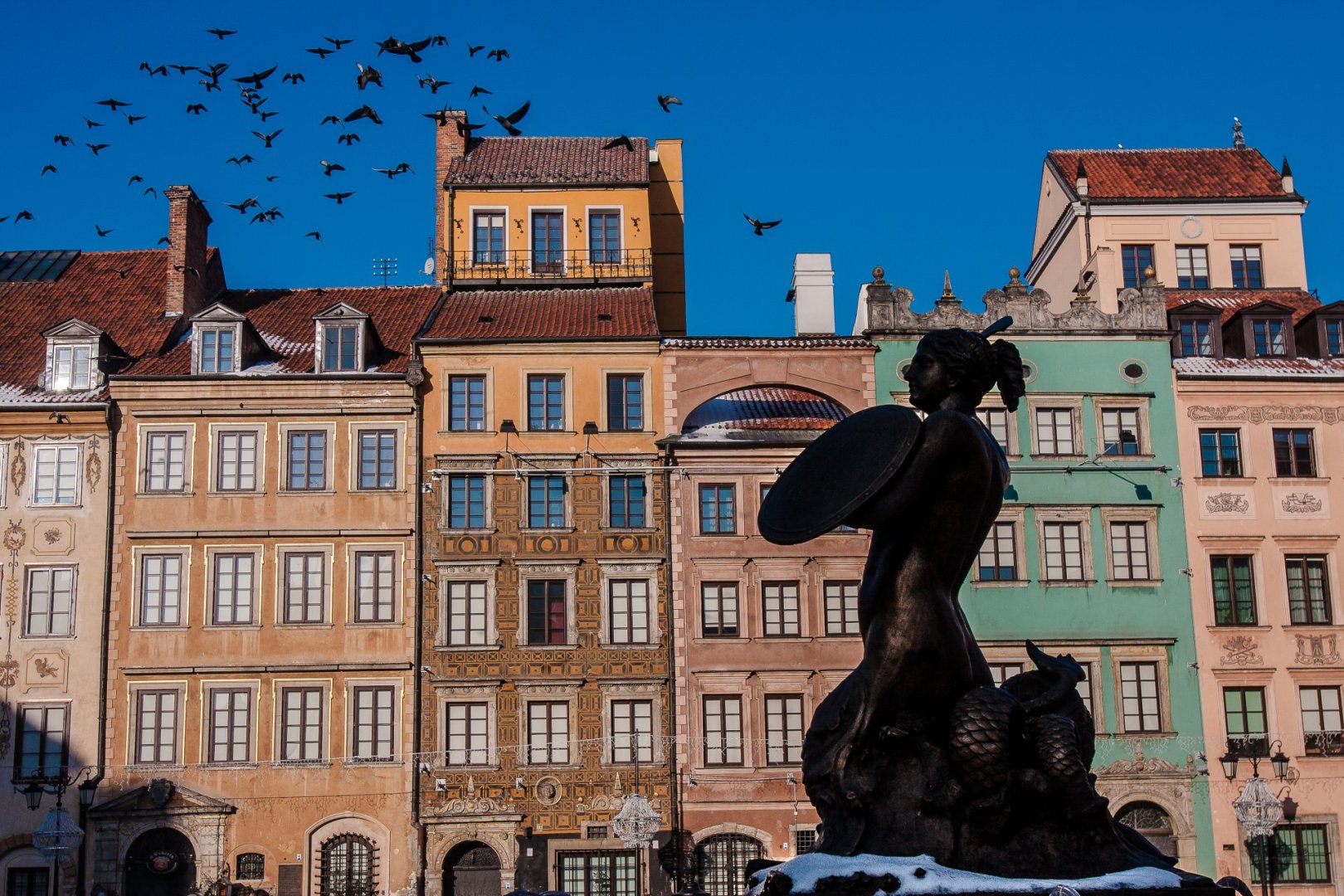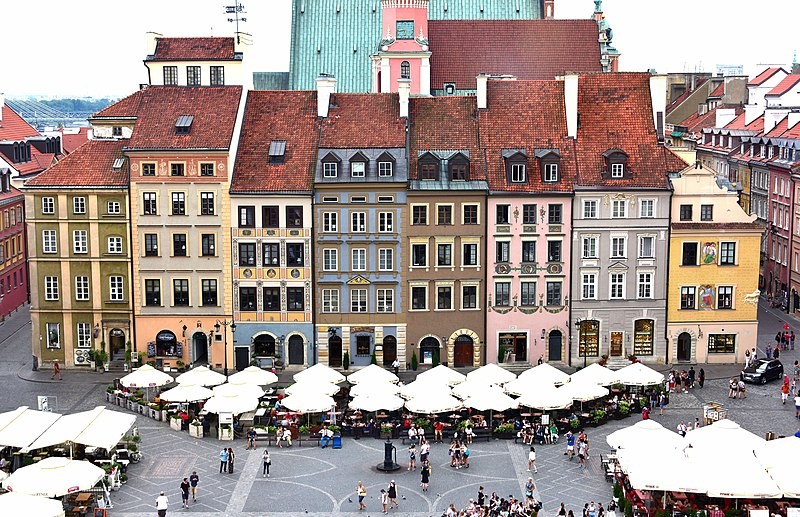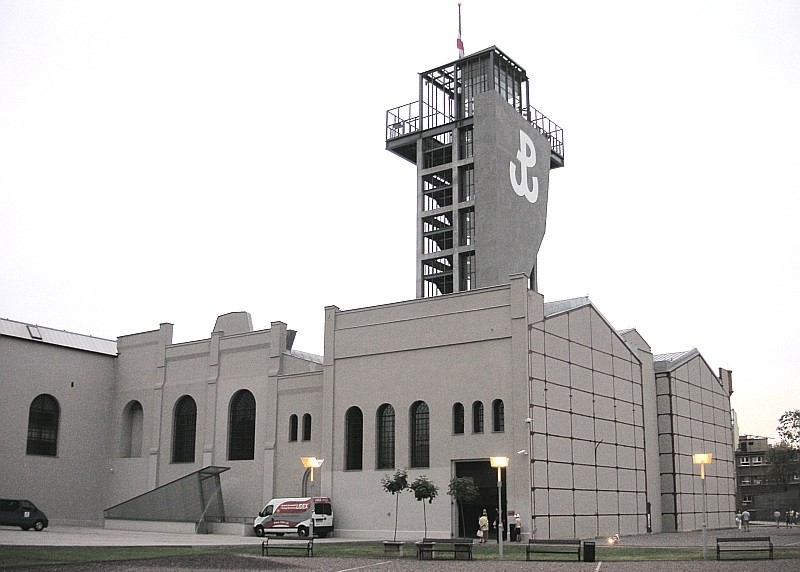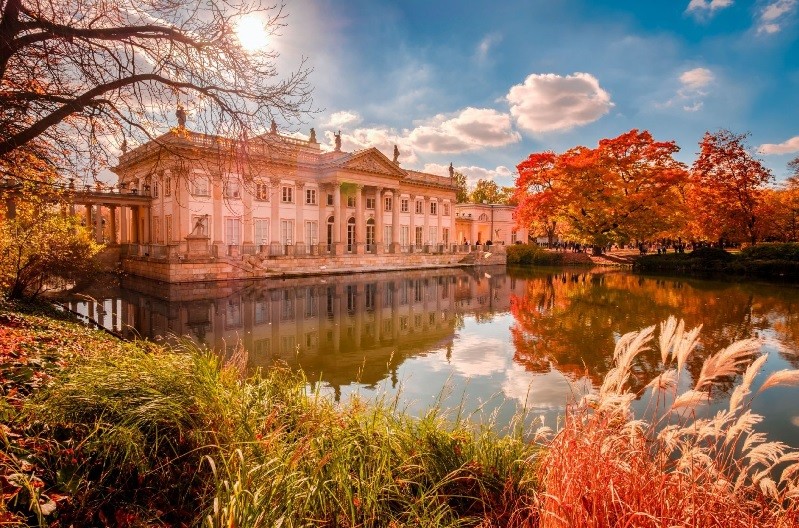



Warsaw is often referred to as a phoenix city as it was immensly rebuilt after WWII. This is also one of the reasons why it has been enlisted at UNESCO World Heritage List. Tourists usually say that a visit here was a great surprise for them as they hadn't even known that there is so much to see in the Polish capital. We invite you to discover this bustling and vibrant city and all its highlights during educational tour for students. Discover dark WWII history and Jewish heritage in Poland. Explore beautiful palaces and modern museums and of course the Communist symbol of the city - Palace of Culture and Science. Find out what legendary Polish hospitality means.
5 days / 4 nights
BB (breakfasts), HB on request
All year
1 capital city
10-50
Calm
Up to 30 days*

Arrival to Warsaw. Check in at your hotel/hostel. The Old Town sightseeing with a guide. In the afternoon sightseeing of Palace of Culture and Science interiors with a guide.

Warsaw is the capital of Poland and the largest city in the country in which about 2 million people live. Warsaw's Old Town is a real pearl of the capital. Enlisted at the UNESCO World Heritage List, delights with colourful tenements and the unique atmosphere of narrow streets. On the Old Town Square you will meet the Mermaid - the official symbol of the city. You'll see the Barbican and the bell on Kanona Street. You can also visit the Royal Castle, the former home of Polish rulers. Here it is possible to see the ro...

Palace of Culture and Science (Polish: Pałac Kultury i Nauki) in Warsaw is just a 30-minute walk from the Royal Castle. The Palace was built in 3 years by 3,500 Russian workers as a gift from Joseph Stalin. Since it was finished in 1955 is has been the tallest building in Poland, its spire reaches 237 metres and the viewing terrace on the 30 floor (114m.) allows you to admire Warsaw from above. The Palace of Culture and Science has 3288 rooms, including Congress Hall which seats 3,000 people and a swimming pool. In y...

The Old Town Square was established at the turn of the 13th and 14th centuries. It has the shape of a rectangle measuring 90 x 73 m. The market served commercial and public functions. Here fairs, executions and burning of forbidden books took place. There were also municipal and state ceremonies and processions. Now, the Old Town Square is one of the most important places on the cultural and tourist map of Warsaw, due to the fact that in 1980 Warsaw's Old Town was entered on the UNESCO World Cultural Heritage List. D...

Cathedral Basilica of St. John the Baptist is located in the Old Town of Warsaw at 8 Świętojańska street. It is one of the oldest temple in Warsaw. It was here that the coronation of King Stanisław August Poniatowski in 1764 took place, as well as the swearing in of the first European Constitution of May 3 in 1791. In the crypts of the basilica there are the tombs of Mazovian dukes, Warsaw archbishops, the last king of Poland Stanisław August Poniatowski, the first Polish president Gabriel Narutowicz, writer and Nobe...

The Presidential Palace is a located on Krakowskie Przedmieście street. Since 1994, it has been the official seat of the President of the Republic of Poland. It is the largest palace in Warsaw. Consists of a four-storey main body and two lower side wings. The palace was rebuilt many times. Lech Walesa was the first president who live here in 1994. In front of the Presidential Palace there is a monument of prince Józef Poniatowski, sitting on a horse and holding a sword in his right hand. Visiting the Presidential Pa...

The Warsaw Barbican was established in the 16th century as an element of the defensive walls of the Old Town. The Barbican was to increase the security of entry to Old Warsaw through the New Town Gate and to ensure the side defense of the neighboring walls. It had the form of a three-level semicircular bastion manned by fusiliers. It was designed by the architect Jan Baptist from Venice. Currently, in the barbican there is an exhibition of the Museum of Warsaw (open in the summer season) dedicated to the defensive wa...

The Church of the Holy Cross is located on Krakowskie Przedmieście, in the Śródmieście district. It is owned by the missionary priests (Congregation of the Missionary Fathers of Saint Vincent de Paul). The church was built in the years 1679-1696 in the baroque style. Its designer was the royal court architect Józef Szymon Bellotti. In front of the entrance to the church, there is a figure of Christ carrying the cross. In the past, ceremonial services, patriotic demonstrations and funerals of outstanding Poles - write...

The Mermaid Monument is one of the most recognizable Warsaw monuments and is often considered one of the city's symbols. Set in the middle of the Warsaw Old Town Square in 1855, the monument was made by Konstanty Hegel and cast in the factory of Karol Juliusz Minter. It depicts the Mermaid as a melusine emerging from the foaming waves, with a spirally twisted tail, holding a sword in her raised right hand and a shield in her left hand. The monument was the first monument of the Warsaw coat of arms.

Breakfast. Transfer to Copernicus Science Centre and sightseeing. Optional lunch break in the centre. Next transfer to Warsaw Rising Museum. Sightseeing with a museum guide.

Copernicus Science Centre in Warsaw is a place striving to popularise science. It is one of the youngest museums in the capital as it was opened only in 2010. It is also one of the most modern museums in Warsaw and definitely one of the most popular. It is situated at 20 Wybrzeże Kościuszkowskie Street. The main aim of the center is to popularize science and visitors learn via play and performing experiments on their own. The entire exhibition is very modern and interactive. The museum has 6 thematic exhibitions in w...

Warsaw Rising Museum is located just 3 kilometres from the Royal Castle. The museum was opened in 2004 and is situated at 79 Grzybowska Street. The main aim of the museum is to provide documentation and present history of Warsaw uprising during the Second World War and activities of Polish Underground State. The exhibition shows everyday life and fights during Nazi occupation and the fate of the insurgents during communist regime in People’s Republic of Poland (PRL). The museum has gathered 30 000 exhibits. The exhib...

Breakfast. Transfer to POLIN Museum. Sightseeing with the guide of chosen thematic tour. Break for private lunch in the museum. Sightseeing of National Stadium (chosen thematic tour). Return to your hotel/hostel.

Museum of the History of Polish Jews – it is a new, ultramodern cultural museum on the map of Warsaw. It is situated at 6 Mordechaja Danielewicza Street in the place which was former Jewish district and also later on Warsaw Ghetto. The museum is a place dedicated to all those who are interested in heritage of Polish Jews and it is a symbol of breakthrough in Polish-Jewish relations during 1000 years history from Medieval times up till now. It is a place of meetings of people who want to know the past and current Jewi...

It is situated at 1 Józefa Poniatowskiego Street and is visible from various viewing point in the capital. It was erected in 2008-2011 for UEFA football championships Euro 2012 at old site of Decade Stadium which before the new stadium construction had been known as Europe Fair. Officially the stadium was opened in January 2012. It offers seats for 58 500 supporters, including 4600 higher standard seats and 69 private boxes for 800 viewers. Currently apart from various sport and artistic events tourists can enjoy 5 s...

The Ghetto Heroes Monument is a monumnt at Zamenhofa Street in Muranów, commemorating the Warsaw Ghetto Uprising of 1943 during the Second World War. The monument is the work of Natan Rapaport, designed by Marek Suzin. It was unveiled next to an earlier monument on April 19, 1948, on the fifth anniversary of the outbreak of the Warsaw Ghetto Uprising. The monument stands 11 meters tall. At the bottom of the monument there is a sign in three languages: Polish, Yiddish and Hebrew - "Jewish nation to its fighters and ma...

Breakfast. Sightseeing of Royal Castle in Warsaw. In the afternoon a walk in Royal Baths or Wilanów polaces' parks. Optional possibility to enter one of the palaces.

The Royal Castle, located in the very heart of Warsaw, is the last seat of Polish monarchs. Its history goes as far as the 14th century, when the Great Tower was built. The majority of work dates back to the late 16 and 17 centuries. Despite of numerous adversities, including the partitions of Poland and almost complete destruction during World War II, the Royal Castle is still open to the public. Various exhibitions and works of art can be seen either individually or with a guide, with plenty of language options to ...

Royal Baths or Łazienki Królewskie is the largest park in the centre of Warsaw. Łazienki are situated halfway down the Royal Route, between Royal Castle and Wilanów. On the area of 76 hectares one may find over 40 points of interest and numerous historic buildings, designed by the king Stanisław August Poniatowski’s in-court architects. Palace on the Isle, Roman Theatre, Myśliwiecki Palace or Chopin Monument are just a small selection. Łazienki Królewskie host various cultural and entertainment events, displays and e...

The Wilanów Palace, together with its garden, is one of the most beautiful objects of its type in Poland. Baroque palace and the meticulously designed surrounding gardens, situated at the end of the Royal Road and built for the king John III Sobieski, are filled with Polish as well as European culture. Wilanów hosts many exhibitions and concerts, including the International Summer Early Music Academy. The Wilanów Palace also houses one Poland’s first ever museums, established in 1805.

Breakfast. Check out from your hotel/hostel. Departure.
Local guides, museum guides, optional driver
Palace of Culture and Science (interiors), Copernicus Science Centre, Warsaw Rising Museum, POLIN Museum, National Stadium, Royal Castle, optional Royal Baths or Wilanów Palace entrance
Coach
Hotel/hostel for sightseeing trips
Hotel/hostel for sightseeing trips
English, German, Norwegian, French, Spanish, Italian and others on request
City tour
Copernicus Centre is fully interactive museum. You have to touch and experience everything. There are no guides, you are welcome to discover everything on your own. There are of course Polish and English explanations and instructions everywhere.

The Polish capital has much to offer for culture lovers: music, history, amazing architecture. Warsaw is often called a phoenix city as it was meticulously rebuilt after fatal losses during WWII. Nowadays, it is a modern and vibrant capital city t...

Warsaw has many marvels to discover. As most of contemporary European capital cities, it enchants visitors with vibrant variety of attractions and quick pace and energy. The city that survived the calamity of WWII, still surprises with its amazing...

Poland is an outstanding country in the central Europe, still undiscovered by wider masses of tourists. Go on a five day adventure with three Polish capitals: Warsaw - administrative, political, economy and media centre of the country; Cracow - hi...

Discover the darkest history of human kind. You will experience the world's most gripping history through the lenses of the modern museums and the world famous memory sites. Study World War II in the place where it started and discover the extensi...